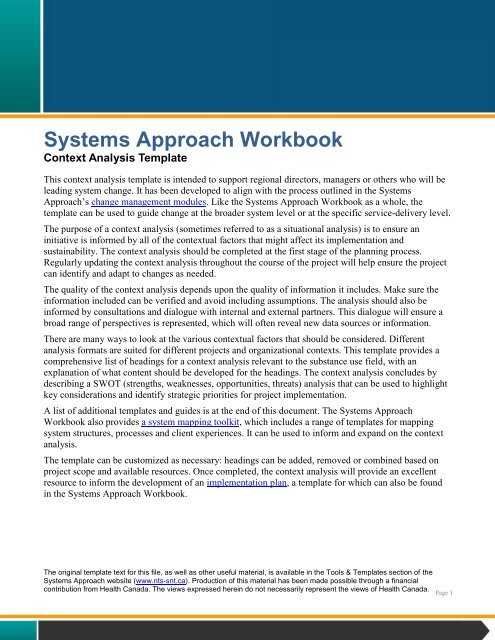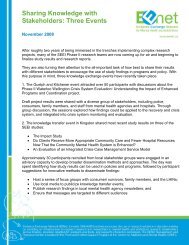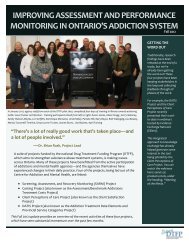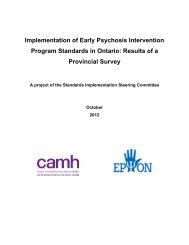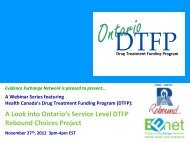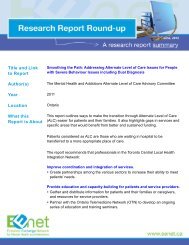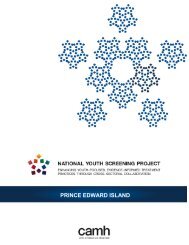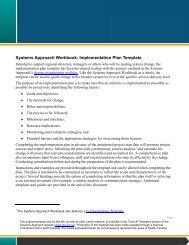Systems Approach Workbook: Context Analysis Template - EENet
Systems Approach Workbook: Context Analysis Template - EENet
Systems Approach Workbook: Context Analysis Template - EENet
You also want an ePaper? Increase the reach of your titles
YUMPU automatically turns print PDFs into web optimized ePapers that Google loves.
<strong>Systems</strong> <strong>Approach</strong> <strong>Workbook</strong><br />
<strong>Context</strong> <strong>Analysis</strong> <strong>Template</strong><br />
This context analysis template is intended to support regional directors, managers or others who will be<br />
leading system change. It has been developed to align with the process outlined in the <strong>Systems</strong><br />
<strong>Approach</strong>’s change management modules. Like the <strong>Systems</strong> <strong>Approach</strong> <strong>Workbook</strong> as a whole, the<br />
template can be used to guide change at the broader system level or at the specific service-delivery level.<br />
The purpose of a context analysis (sometimes referred to as a situational analysis) is to ensure an<br />
initiative is informed by all of the contextual factors that might affect its implementation and<br />
sustainability. The context analysis should be completed at the first stage of the planning process.<br />
Regularly updating the context analysis throughout the course of the project will help ensure the project<br />
can identify and adapt to changes as needed.<br />
The quality of the context analysis depends upon the quality of information it includes. Make sure the<br />
information included can be verified and avoid including assumptions. The analysis should also be<br />
informed by consultations and dialogue with internal and external partners. This dialogue will ensure a<br />
broad range of perspectives is represented, which will often reveal new data sources or information.<br />
There are many ways to look at the various contextual factors that should be considered. Different<br />
analysis formats are suited for different projects and organizational contexts. This template provides a<br />
comprehensive list of headings for a context analysis relevant to the substance use field, with an<br />
explanation of what content should be developed for the headings. The context analysis concludes by<br />
describing a SWOT (strengths, weaknesses, opportunities, threats) analysis that can be used to highlight<br />
key considerations and identify strategic priorities for project implementation.<br />
A list of additional templates and guides is at the end of this document. The <strong>Systems</strong> <strong>Approach</strong><br />
<strong>Workbook</strong> also provides a system mapping toolkit, which includes a range of templates for mapping<br />
system structures, processes and client experiences. It can be used to inform and expand on the context<br />
analysis.<br />
The template can be customized as necessary: headings can be added, removed or combined based on<br />
project scope and available resources. Once completed, the context analysis will provide an excellent<br />
resource to inform the development of an implementation plan, a template for which can also be found<br />
in the <strong>Systems</strong> <strong>Approach</strong> <strong>Workbook</strong>.<br />
The original template text for this file, as well as other useful material, is available in the Tools & <strong>Template</strong>s section of the<br />
<strong>Systems</strong> <strong>Approach</strong> website (www.nts-snt.ca). Production of this material has been made possible through a financial<br />
contribution from Health Canada. The views expressed herein do not necessarily represent the views of Health Canada. Page 1
A <strong>Systems</strong> <strong>Approach</strong>: Sample Content <strong>Analysis</strong> <strong>Template</strong><br />
<strong>Context</strong> <strong>Analysis</strong> for [Project Name]<br />
Project Lead: Name, position and contact information.<br />
Project Description: Provide a brief description of the project. What should be included in a 30-second<br />
“elevator pitch” to communicate the fundamentals of the project? If the context analysis is being<br />
conducted before the project is fully defined, which is often a good idea, identify the broad purpose or<br />
goals driving project development.<br />
Internal Considerations: The first set of considerations focuses on things that are internal to the<br />
organization or within the organization’s control.<br />
Organizational Mandate: How does the project align with and support the organizational mandate?<br />
Vision, values and mission statements can also be considered.<br />
Organizational Structure: What is the administrative structure and governance model within which<br />
the project might occur or that the project will be revising?<br />
Current <strong>Approach</strong>: What are the existing approaches, processes and activities for system<br />
coordination or service delivery that may be affected by the project? Are there evaluations or project<br />
reports that can provide data about the impact of the current approach?<br />
Ongoing Projects: What other projects are happening prior to, during and following the project<br />
being considered? How will these projects interact in terms of staff, clients, physical resources and<br />
partners involved? Are there links or economies of scale that can be taken advantage of?<br />
Organizational Culture: What is the leadership approach in the organization? Is there a culture of<br />
trust and dialogue? Is the culture supportive of innovation and knowledge exchange? Because past<br />
behaviour is predictive of future behaviour, how have other changes been received in the past? If the<br />
project involves a significant change, organizational experience with similar changes will help<br />
determine initial staff response. Consider whether change fatigue may be an issue and if there are<br />
lessons learned from past experiences that can be brought forward. The change management<br />
modules in the <strong>Systems</strong> <strong>Approach</strong> <strong>Workbook</strong> provide a guide to using a change management<br />
approach.<br />
Finances: What financial resources are or may be available to support the project? What is the<br />
funding projection for both the project and organization as a whole (e.g., cutbacks versus new<br />
resources)?<br />
Human Resources: What skills and characteristics are brought to the table by staff involved in the<br />
project? What are their current workload levels? Consider all roles, from administrative support to<br />
senior management to frontline practitioners. Will there be unionized staff involved? If so, what<br />
agreements are in place? Who are the key union contacts to involve in consultations and planning?<br />
Are there any ongoing or historical conflicts that may raise issues? Who else within the organization<br />
should be consulted or involved?<br />
Physical and Technological Resources: What resources are in place or in development that will be<br />
used to support the project? Consider office space, computer hardware and software, and program<br />
space, if applicable.<br />
Page 2
A <strong>Systems</strong> <strong>Approach</strong>: Sample Content <strong>Analysis</strong> <strong>Template</strong><br />
External Considerations: The second set of considerations focuses on things that are external to the<br />
organization or outside of the organization’s control.<br />
System Complexity: The level of system complexity in which a project or change is taking place<br />
should inform how change is approached. The System Thinking and Complexity brief in the<br />
<strong>Systems</strong> <strong>Approach</strong> <strong>Workbook</strong> provides additional information on evaluating and working with<br />
complexity.<br />
Politics: What local, regional, provincial or national political priorities or processes might influence<br />
the project? Examples may include legislative change, pending elections, politically appointed<br />
working groups or commissions of inquiry, or specific political directives.<br />
Social Trends: What are the socio-demographics, particularly for those affected or targeted by the<br />
project? Are there trends that will affect the project or that the project is responding to? Consider the<br />
social determinants of health: gender, culture, age, income, housing, education and mental health, for<br />
example. What are the current rates and characteristics of substance use in the population? What is<br />
the economic and political context?<br />
System Trends: What are the current rates of service access for the programs involved? What is the<br />
current level of interaction between different components of the system; for example, for various<br />
services within the system as well as community service providers and possible referral sources such<br />
as primary care physicians? Is the system integrated or considering integration with other sectors<br />
such as mental health or primary care?<br />
Partnerships: What partners, if any, will be directly involved in the project and to what extent? What<br />
partners will be affected by or interested in the project? What partners should be informed or may<br />
support it? What are the current relationships and mechanisms for engagement with these partners?<br />
Partner Characteristics: What are the characteristics of the partners that will be affected by or are<br />
being targeted for collaboration on the project? Consider, for example, mandate, priorities, funding,<br />
structure, personnel and approach.<br />
Page 3
A <strong>Systems</strong> <strong>Approach</strong>: Sample Content <strong>Analysis</strong> <strong>Template</strong><br />
Summary Table: The following table provides a template that could be used in the brainstorming phase<br />
or to summarize more detailed information contained in a narrative analysis.<br />
Project: Developing Community Capacity for Early Intervention<br />
Category Consideration Impact / Relevance<br />
Internal Considerations<br />
Organizational<br />
mandate<br />
“To reduce the harm<br />
associated with<br />
substance use”<br />
Hierarchical model<br />
Alignment: Research indicates that early identification and intervention is<br />
associated with reduced harm to individuals and society.<br />
Organizational<br />
structure<br />
Hierarchical approval processes will need to be accounted for in project<br />
timelines.<br />
Current approach Service focus on Priority area through the project will be shifting the service focus toward<br />
specialized care lower tiers.<br />
Ongoing projects Integration between Project is taking up significant administrative resources. It is anticipated to<br />
addictions and mental move to the service level along a similar timeline to the community<br />
health<br />
capacity project being implemented.<br />
Introduction of a new Project involves many of the same management-level personnel from the<br />
data collection system ministry and from existing community-based services.<br />
Organizational Some change fatigue Change of ministry, integration with mental health and a new quality<br />
culture<br />
assurance process were introduced within the past five years.<br />
Motivated<br />
Staff members, particularly those in the community, see the gaps in the<br />
system and are eager to align with evidence that will result in improved<br />
client care.<br />
Finances Level core funding No additional resources for the project.<br />
Human resources Well-staffed<br />
Additional resources brought in previously to support integration process<br />
administrative support may be leveraged.<br />
Frontline workers are Impact on workload will be a significant consideration, particularly if no<br />
fully staffed and funding is available for additional resources.<br />
working overtime<br />
Physical and<br />
technical resources<br />
External Considerations<br />
New computer systems<br />
recently installed in all<br />
community service<br />
offices<br />
Computer systems may provide a mechanism for training and supporting<br />
knowledge exchange and communications during project implementation.<br />
System complexity Complex Cannot expect to implement the project and see immediate impact. We<br />
will need to account for influence of other system components.<br />
Politics<br />
Addictions identified as<br />
a priority by new<br />
Project aligns with directives from the new minister to improve services.<br />
However, ministerial focus is more on developing specialized services.<br />
minister<br />
Social trends Average age is<br />
increasing<br />
Need to ensure capacity development takes place in services dealing with<br />
older adults, not just youth.<br />
10 percent increase in Need to engage community groups providing services to new Canadians.<br />
System trends<br />
Partnerships<br />
new Canadians last year<br />
Majority of referrals to<br />
outpatient services<br />
coming from criminal<br />
justice system<br />
CrossRoads<br />
Community Services<br />
Centre<br />
Need to look at why criminal justice system (CJS) referrals are high. Is<br />
this indicative of a lack of knowledge or resources for sources such as<br />
primary care and multidisciplinary social outreach, or something else?<br />
Need to ensure that services are well equipped to deal with CJS clients.<br />
Target partner with a history of interaction on working groups and<br />
committees, but no concrete collaboration.<br />
Page 4
A <strong>Systems</strong> <strong>Approach</strong>: Sample Content <strong>Analysis</strong> <strong>Template</strong><br />
Project: Developing Community Capacity for Early Intervention<br />
Category Consideration Impact / Relevance<br />
Partner<br />
characteristics<br />
15 staff, primarily<br />
community nurses and<br />
social workers with<br />
little training in<br />
substance use<br />
Will need to provide training, and work with the Centre to balance time<br />
required for client service with time required for administration and<br />
training.<br />
SWOT <strong>Analysis</strong>: What are the key strengths, weaknesses, opportunities and threats identified in this<br />
context analysis? Strengths and weaknesses are generally internal or within the organization’s control,<br />
while opportunities and threats are external and might be beyond the organization’s control. The<br />
additional templates and guides section at the end of this document provides links to online resources<br />
with more information on conducting a SWOT analysis.<br />
Strengths Weaknesses Opportunities Threats<br />
Staff motivation to best Funding<br />
Alignment with provincial Change fatigue<br />
serve clients<br />
mental health and addictions<br />
Research evidence<br />
Supportive senior leadership<br />
Next Steps:<br />
History of working in<br />
isolation from other sectors<br />
Expertise in managing<br />
system change<br />
strategy<br />
New shared care protocols<br />
with primary care<br />
Free training resources and<br />
templates on change<br />
management (e.g., CCSA’s<br />
<strong>Systems</strong> <strong>Approach</strong><br />
<strong>Workbook</strong>); possible<br />
collaboration with CCSA<br />
Broader health system<br />
restructuring, including<br />
possible cutbacks<br />
Political direction that does<br />
not align with research<br />
evidence<br />
Once the context analysis is complete, it should be used to inform the project implementation plan. Also<br />
keep in mind that because the context will change over time, this analysis should be updated regularly<br />
and changes analyzed for their impact on the overall implementation process.<br />
Page 5
A <strong>Systems</strong> <strong>Approach</strong>: Sample Content <strong>Analysis</strong> <strong>Template</strong><br />
Additional <strong>Template</strong>s and Guides<br />
Canadian Centre on Substance Abuse. (2012). <strong>Systems</strong> approach workbook: Mapping substance use<br />
systems and client journeys. Ottawa: Author. Retrieved from: http://www.ntssnt.ca/2012%20Document%20Library/nts-systems-approach-mapping-2012-en.pdf<br />
MindTools. (n.d.). SWOT analysis. Retrieved from:<br />
www.mindtools.com/pages/article/newTMC_05.htm.<br />
RapidBI. (2007). SWOT analysis made simple: History, definition, tools, templates & worksheets.<br />
Retrieved from: http://rapidbi.com/swotanalysis.<br />
Renault, V. (n.d.). SWOT analysis: Strengths, weaknesses, opportunities, and threats. Retrieved from:<br />
http://ctb.ku.edu/en/tablecontents/sub_section_main_1049.aspx.<br />
Page 6


